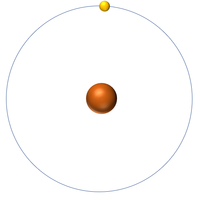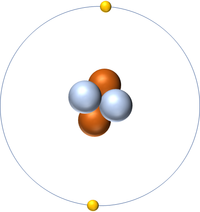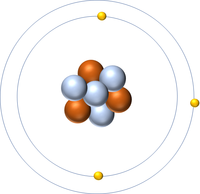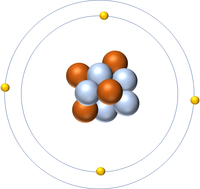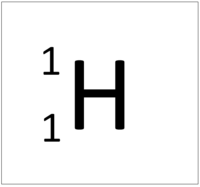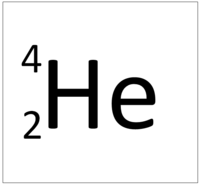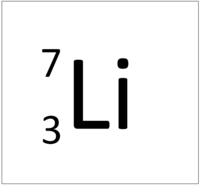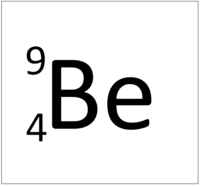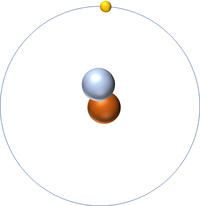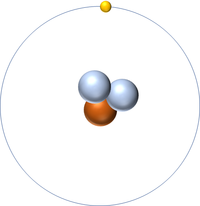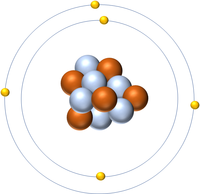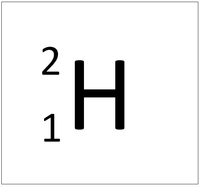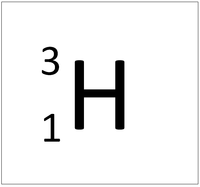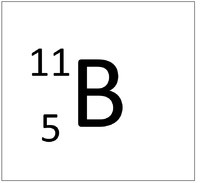Difference between revisions of "Relative Atomic Mass"
(→Examples) |
|||
| (6 intermediate revisions by 2 users not shown) | |||
| Line 33: | Line 33: | ||
|} | |} | ||
| − | ==Key Stage | + | ==Key Stage 4== |
===Meaning=== | ===Meaning=== | ||
[[File:ElementTile.png|right|400px|thumb|An [[element]] tile showing the '''mass number'''.]] | [[File:ElementTile.png|right|400px|thumb|An [[element]] tile showing the '''mass number'''.]] | ||
The '''relative atomic mass''' or '''mass number''' of an [[element]] is the number of [[nucleon]]s ([[proton]]s + [[neutron]]s) in an [[atom]]. | The '''relative atomic mass''' or '''mass number''' of an [[element]] is the number of [[nucleon]]s ([[proton]]s + [[neutron]]s) in an [[atom]]. | ||
| − | The '''relative atomic mass''' in [[gram]]s is also the [[mass]] of one [[mole]] or [[ | + | The '''relative atomic mass''' in [[gram]]s is also the [[mass]] of one [[mole]] or [[Avogadro Constant|6.02x10<sup>23</sup>]] [[atom]]s of the [[element]]. |
===About Relative Atomic Mass=== | ===About Relative Atomic Mass=== | ||
| − | : The '''relative atomic mass''' in [[gram]]s on the [[Periodic Table]] tells the [[mass]] of a [[mole]] of the [[element]]. A [[mole]] of the [[element]] is [[ | + | : The '''relative atomic mass''' in [[gram]]s on the [[Periodic Table]] tells the [[mass]] of a [[mole]] of the [[element]]. A [[mole]] of the [[element]] is [[Avogadro Constant|6.02x10<sup>23</sup>]] [[atom]]s of that [[element]]. |
: Two [[atom]]s of the same [[element]] may have the same [[Atomic Number]] but a different [[Relative Atomic Mass]] depending on the number of [[neutron]]s in the [[nucleus]]. [[Element]]s with different '''mass numbers''' are called [[isotope]]s. | : Two [[atom]]s of the same [[element]] may have the same [[Atomic Number]] but a different [[Relative Atomic Mass]] depending on the number of [[neutron]]s in the [[nucleus]]. [[Element]]s with different '''mass numbers''' are called [[isotope]]s. | ||
: The '''relative atomic mass''' is not affected by the number of [[electron]]s. | : The '''relative atomic mass''' is not affected by the number of [[electron]]s. | ||
| Line 52: | Line 52: | ||
| style="height:20px; width:200px; text-align:center;" |'''Deuterium''' | | style="height:20px; width:200px; text-align:center;" |'''Deuterium''' | ||
| style="height:20px; width:200px; text-align:center;" |'''Tritium''' | | style="height:20px; width:200px; text-align:center;" |'''Tritium''' | ||
| − | | style="height:20px; width:200px; text-align:center;" |''' | + | | style="height:20px; width:200px; text-align:center;" |'''Boron''' |
|- | |- | ||
|[[File:Hydrogen.png|center|200px]] | |[[File:Hydrogen.png|center|200px]] | ||
| Line 64: | Line 64: | ||
|[[File:BoronSymbol.png|center|200px]] | |[[File:BoronSymbol.png|center|200px]] | ||
|- | |- | ||
| − | | style="height:20px; width:200px; text-align:center;" |[[Hydrogen]] has one [[nucleon]] so it has an '''atomic mass''' of 1 and [[ | + | | style="height:20px; width:200px; text-align:center;" |[[Hydrogen]] has one [[nucleon]] so it has an '''atomic mass''' of 1 and [[Avogadro Constant|6.02x10<sup>23</sup>]] (or 1 [[mole]] of) [[atom]]s of [[Hydrogen]] have a [[mass]] of 1g. |
| − | | style="height:20px; width:200px; text-align:center;" |[[ | + | | style="height:20px; width:200px; text-align:center;" |[[Deuterium]] has two [[nucleon]]s so it has an '''atomic mass''' of 2 and [[Avogadro Constant|6.02x10<sup>23</sup>]] (or 1 [[mole]] of) [[atom]]s of [[Deuterium]] have a [[mass]] of 2g. |
| − | | style="height:20px; width:200px; text-align:center;" |[[ | + | | style="height:20px; width:200px; text-align:center;" |[[Tritium]] has three [[nucleon]]s so it has an '''atomic mass''' of 3 and [[Avogadro Constant|6.02x10<sup>23</sup>]] (or 1 [[mole]] of) [[atom]]s of [[Tritium]] have a [[mass]] of 3g. |
| − | | style="height:20px; width:200px; text-align:center;" |[[ | + | | style="height:20px; width:200px; text-align:center;" |[[Boron]] has eleven [[nucleon]]s so it has an '''atomic mass''' of 11 and [[Avogadro Constant|6.02x10<sup>23</sup>]] (or 1 [[mole]] of) [[atom]]s of [[Boron]] have a [[mass]] of 11g. |
|} | |} | ||
| + | |||
| + | ===References=== | ||
| + | ====AQA==== | ||
| + | |||
| + | :[https://www.amazon.co.uk/gp/product/1471851346/ref=as_li_tl?ie=UTF8&camp=1634&creative=6738&creativeASIN=1471851346&linkCode=as2&tag=nrjc-21&linkId=3ac654f4b0da781c49c855a1af4c92ea ''Relative atomic mass (Ar), pages 4-5, 64, GCSE Chemistry, Hodder, AQA ''] | ||
| + | :[https://www.amazon.co.uk/gp/product/1782945571/ref=as_li_tl?ie=UTF8&camp=1634&creative=6738&creativeASIN=1782945571&linkCode=as2&tag=nrjc-21&linkId=9e29fad914244909903e5e93f8a01d228 ''Relative atomic mass, A, pages 13, 21, 41, GCSE Chemistry; The Revision Guide, CGP, AQA ''] | ||
| + | :[https://www.amazon.co.uk/gp/product/1782945598/ref=as_li_tl?ie=UTF8&camp=1634&creative=6738&creativeASIN=1782945598&linkCode=as2&tag=nrjc-21&linkId=ad276ad49df77ab4b40ab4fd0fe10239 ''Relative atomic mass, A, pages 97, 123, GCSE Combined Science; The Revision Guide, CGP, AQA ''] | ||
| + | :[https://www.amazon.co.uk/gp/product/0008158762/ref=as_li_tl?ie=UTF8&camp=1634&creative=6738&creativeASIN=0008158762&linkCode=as2&tag=nrjc-21&linkId=a0fffa35b3ea49a63404f6704e0df7cc ''Relative atomic mass, pages 100-1, GCSE Chemistry; Student Book, Collins, AQA ''] | ||
| + | :[https://www.amazon.co.uk/gp/product/1471851354/ref=as_li_tl?ie=UTF8&camp=1634&creative=6738&creativeASIN=1471851354&linkCode=as2&tag=nrjc-21&linkId=9012a0d354024419214fb3ad5ac44ba0 ''Relative atomic mass, pages 120, 177, GCSE Combined Science Trilogy 1, Hodder, AQA ''] | ||
| + | :[https://www.amazon.co.uk/gp/product/178294639X/ref=as_li_tl?ie=UTF8&camp=1634&creative=6738&creativeASIN=178294639X&linkCode=as2&tag=nrjc-21&linkId=51599bb45a2bfaf7c1b6a978b2ca2616 ''Relative atomic mass, pages 26, 106, GCSE Combined Science Trilogy; Chemistry, CGP, AQA ''] | ||
| + | :[https://www.amazon.co.uk/gp/product/1782945962/ref=as_li_tl?ie=UTF8&camp=1634&creative=6738&creativeASIN=1782945962&linkCode=as2&tag=nrjc-21&linkId=476bb5c8d1dfb5c08ac81b6d4d1c98d8 ''Relative atomic mass, pages 26, 112, GCSE Chemistry, CGP, AQA ''] | ||
| + | :[https://www.amazon.co.uk/gp/product/0198359381/ref=as_li_tl?ie=UTF8&camp=1634&creative=6738&creativeASIN=0198359381&linkCode=as2&tag=nrjc-21&linkId=47c8d1ae58d8b3a5e2094cd447154558 ''Relative atomic mass, pages 62-63, GCSE Chemistry; Third Edition, Oxford University Press, AQA ''] | ||
| + | |||
| + | ====Edexcel==== | ||
| + | |||
| + | :[https://www.amazon.co.uk/gp/product/1292120193/ref=as_li_tl?ie=UTF8&camp=1634&creative=6738&creativeASIN=1292120193&linkCode=as2&tag=nrjc-21&linkId=572df39392fb4200db8391d98ae6314e ''Ar (relative atomic mass), page 167, GCSE Combined Science, Pearson Edexcel ''] | ||
| + | :[https://www.amazon.co.uk/gp/product/1292120215/ref=as_li_tl?ie=UTF8&camp=1634&creative=6738&creativeASIN=1292120215&linkCode=as2&tag=nrjc-21&linkId=8f96ddb76196848bafdb124354e4cf77 ''Ar (relative atomic mass), page 23, GCSE Chemistry, Pearson, Edexcel ''] | ||
| + | :[https://www.amazon.co.uk/gp/product/1292120215/ref=as_li_tl?ie=UTF8&camp=1634&creative=6738&creativeASIN=1292120215&linkCode=as2&tag=nrjc-21&linkId=8f96ddb76196848bafdb124354e4cf77 ''Relative atomic masses (RAM), pages 23, 26, 29, GCSE Chemistry, Pearson, Edexcel ''] | ||
| + | :[https://www.amazon.co.uk/gp/product/1782945725/ref=as_li_tl?ie=UTF8&camp=1634&creative=6738&creativeASIN=1782945725&linkCode=as2&tag=nrjc-21&linkId=694be7494de75af3349537d34e13f7f0 ''Relative atomic masses, pages 17, 28, GCSE Chemistry; The Revision Guide, CGP, Edexcel ''] | ||
| + | :[https://www.amazon.co.uk/gp/product/1782948147/ref=as_li_tl?ie=UTF8&camp=1634&creative=6738&creativeASIN=1782948147&linkCode=as2&tag=nrjc-21&linkId=f63dcd8345f4e49c717b39a228a36c7c ''Relative atomic masses, pages 37, 38, 85, GCSE Chemistry, CGP, Edexcel ''] | ||
| + | :[https://www.amazon.co.uk/gp/product/1782945741/ref=as_li_tl?ie=UTF8&camp=1634&creative=6738&creativeASIN=1782945741&linkCode=as2&tag=nrjc-21&linkId=30da4f2178da182547b62a7329d13b57 ''Relative atomic masses, pages 80, 91, GCSE Combined Science; The Revision Guide, CGP, Edexcel ''] | ||
| + | |||
| + | ====OCR==== | ||
| + | :[https://www.amazon.co.uk/gp/product/1782945695/ref=as_li_tl?ie=UTF8&camp=1634&creative=6738&creativeASIN=1782945695&linkCode=as2&tag=nrjc-21&linkId=ceafcc80bcad6b6754ee97a0c7ceea53 ''Relative atomic mass (Ar), page 104, Gateway GCSE Combined Science; The Revision Guide, CGP, OCR ''] | ||
| + | :[https://www.amazon.co.uk/gp/product/1782945679/ref=as_li_tl?ie=UTF8&camp=1634&creative=6738&creativeASIN=1782945679&linkCode=as2&tag=nrjc-21&linkId=a2db42f7b4bdf10cafaafa3bb9120940 ''Relative atomic mass (Ar), pages 15, 16, 31, 38, Gateway GCSE Chemistry; The Revision Guide, CGP, OCR ''] | ||
| + | :[https://www.amazon.co.uk/gp/product/0198359829/ref=as_li_tl?ie=UTF8&camp=1634&creative=6738&creativeASIN=0198359829&linkCode=as2&tag=nrjc-21&linkId=90e8d7b4f039d53035238fa0320fe00b ''Relative atomic mass, page 36, Gateway GCSE Chemistry, Oxford, OCR ''] | ||
Latest revision as of 18:03, 18 December 2019
Contents
Key Stage 3
Meaning
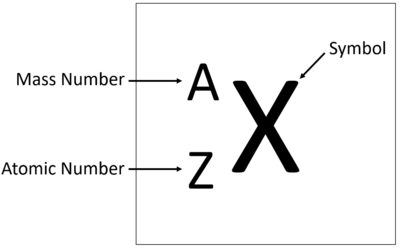
An element tile showing the mass number.
The Atomic Mass or mass number is the number of nucleons (protons + neutrons) in an atom.
About The Atomic Mass
- Two atoms of the same element may have the same Atomic Number but a different Atomic Mass depending on the number of neutrons in the nucleus. Elements with different mass numbers are called isotopes.
- The atomic mass is not affected by the number of electrons.
- Only the particles in the nucleus affect the atomic mass.
Examples
| Hydrogen | Helium | Lithium | Beryllium |
| Hydrogen has one nucleon so it has an atomic mass of 1. | Helium has four nucleons so it has an atomic mass of 4. | Lithium has seven nucleons so it has an atomic mass of 7. | Beryllium has nine nucleons so it has an atomic mass of 9. |
Key Stage 4
Meaning

An element tile showing the mass number.
The relative atomic mass or mass number of an element is the number of nucleons (protons + neutrons) in an atom.
The relative atomic mass in grams is also the mass of one mole or 6.02x1023 atoms of the element.
About Relative Atomic Mass
- The relative atomic mass in grams on the Periodic Table tells the mass of a mole of the element. A mole of the element is 6.02x1023 atoms of that element.
- Two atoms of the same element may have the same Atomic Number but a different Relative Atomic Mass depending on the number of neutrons in the nucleus. Elements with different mass numbers are called isotopes.
- The relative atomic mass is not affected by the number of electrons.
- Only the particles in the nucleus affect the relative atomic mass.
Examples
| Hydrogen | Deuterium | Tritium | Boron |
| Hydrogen has one nucleon so it has an atomic mass of 1 and 6.02x1023 (or 1 mole of) atoms of Hydrogen have a mass of 1g. | Deuterium has two nucleons so it has an atomic mass of 2 and 6.02x1023 (or 1 mole of) atoms of Deuterium have a mass of 2g. | Tritium has three nucleons so it has an atomic mass of 3 and 6.02x1023 (or 1 mole of) atoms of Tritium have a mass of 3g. | Boron has eleven nucleons so it has an atomic mass of 11 and 6.02x1023 (or 1 mole of) atoms of Boron have a mass of 11g. |
References
AQA
- Relative atomic mass (Ar), pages 4-5, 64, GCSE Chemistry, Hodder, AQA
- Relative atomic mass, A, pages 13, 21, 41, GCSE Chemistry; The Revision Guide, CGP, AQA
- Relative atomic mass, A, pages 97, 123, GCSE Combined Science; The Revision Guide, CGP, AQA
- Relative atomic mass, pages 100-1, GCSE Chemistry; Student Book, Collins, AQA
- Relative atomic mass, pages 120, 177, GCSE Combined Science Trilogy 1, Hodder, AQA
- Relative atomic mass, pages 26, 106, GCSE Combined Science Trilogy; Chemistry, CGP, AQA
- Relative atomic mass, pages 26, 112, GCSE Chemistry, CGP, AQA
- Relative atomic mass, pages 62-63, GCSE Chemistry; Third Edition, Oxford University Press, AQA
Edexcel
- Ar (relative atomic mass), page 167, GCSE Combined Science, Pearson Edexcel
- Ar (relative atomic mass), page 23, GCSE Chemistry, Pearson, Edexcel
- Relative atomic masses (RAM), pages 23, 26, 29, GCSE Chemistry, Pearson, Edexcel
- Relative atomic masses, pages 17, 28, GCSE Chemistry; The Revision Guide, CGP, Edexcel
- Relative atomic masses, pages 37, 38, 85, GCSE Chemistry, CGP, Edexcel
- Relative atomic masses, pages 80, 91, GCSE Combined Science; The Revision Guide, CGP, Edexcel
